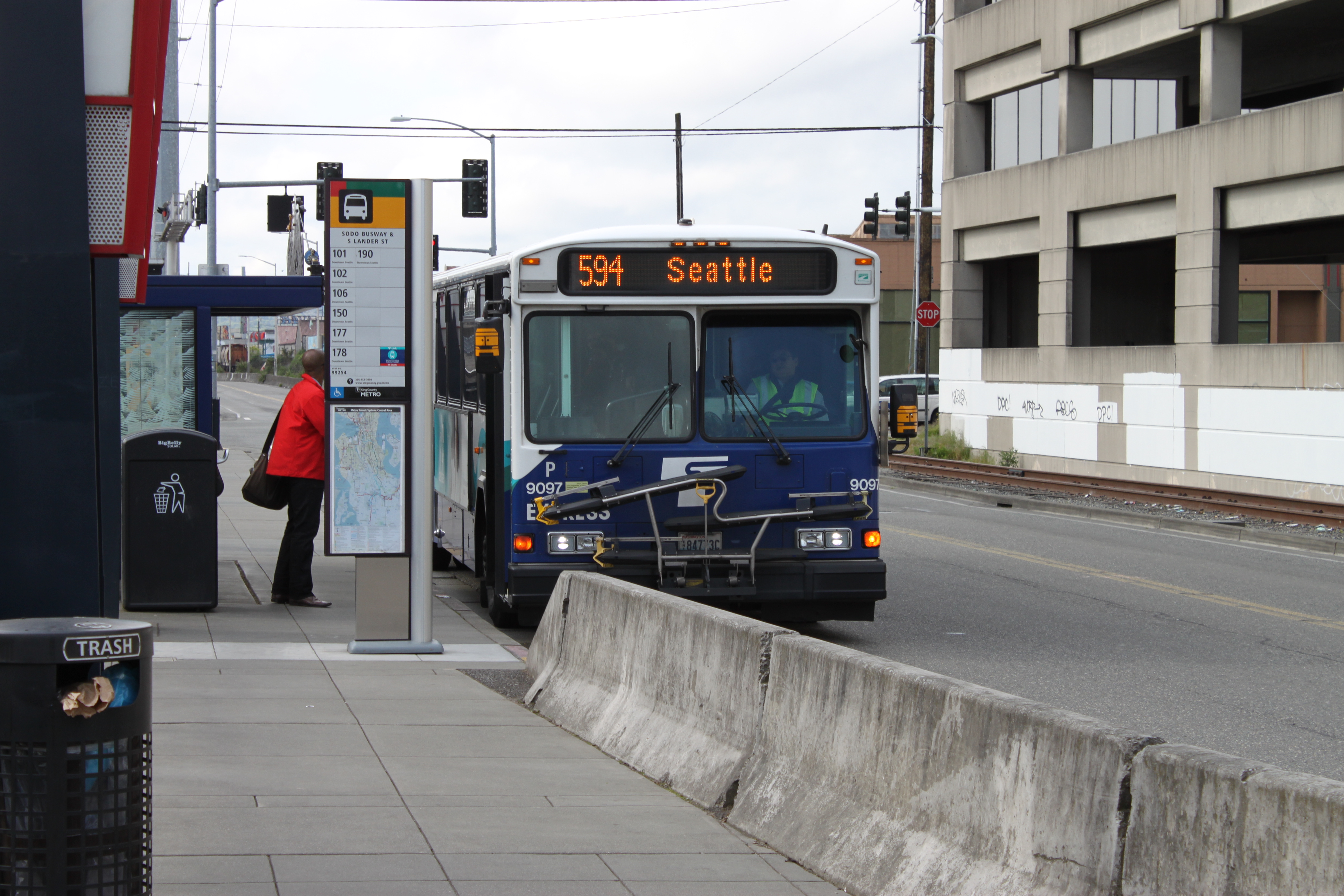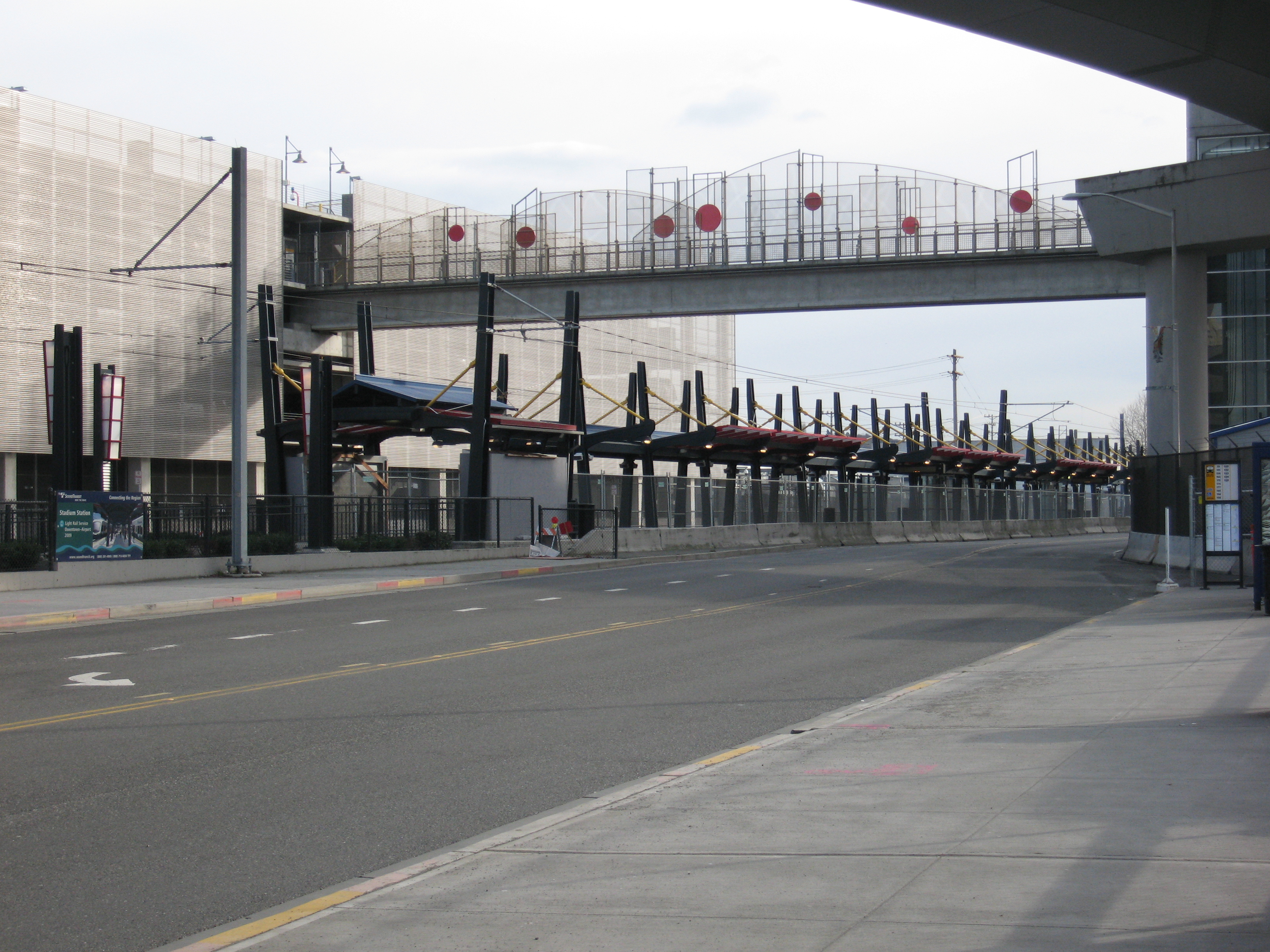SODO Busway on:
[Wikipedia]
[Google]
[Amazon]
The SODO Busway, also referred to as the E-3 Busway, is a busway in the SoDo neighborhood of
 The SODO Busway runs through the SODO area of Seattle that has historically been used for industrial purposes, and today remains largely zoned for industry. The right-of-way was originally used by
The SODO Busway runs through the SODO area of Seattle that has historically been used for industrial purposes, and today remains largely zoned for industry. The right-of-way was originally used by  In September 1999, the Pierce Transit express routes were replaced by Sound Transit Express routes, including on the busway.
In September 1999, the Pierce Transit express routes were replaced by Sound Transit Express routes, including on the busway.
 In November 2003, Sound Transit began construction of the Central Link light rail line, which included relocating utilities along the busway. In August 2005, the first rails were laid adjacent to busway from Holgate to Lander. Construction of SODO and
In November 2003, Sound Transit began construction of the Central Link light rail line, which included relocating utilities along the busway. In August 2005, the first rails were laid adjacent to busway from Holgate to Lander. Construction of SODO and
Seattle
Seattle ( ) is a seaport city on the West Coast of the United States. It is the seat of King County, Washington. With a 2020 population of 737,015, it is the largest city in both the state of Washington and the Pacific Northwest regio ...
, Washington
Washington commonly refers to:
* Washington (state), United States
* Washington, D.C., the capital of the United States
** A metonym for the federal government of the United States
** Washington metropolitan area, the metropolitan area centered on ...
. It has four stops, including two that connect to Link light rail
Link light rail is a light rail rapid transit system serving the Seattle metropolitan area in the U.S. state of Washington. It is managed by Sound Transit in partnership with local transit providers, and consists of two non-connected lines: t ...
stations, and functions as an extension of the Downtown Seattle Transit Tunnel, which was formerly used by buses. The busway is served by ten bus routes—seven King County Metro routes from southern King County
King County is located in the U.S. state of Washington. The population was 2,269,675 in the 2020 census, making it the most populous county in Washington, and the 13th-most populous in the United States. The county seat is Seattle, also the st ...
and three Sound Transit Express routes from Pierce County.
Route
The busway begins at an intersection with S Spokane Street, which is split into acouplet
A couplet is a pair of successive lines of metre in poetry. A couplet usually consists of two successive lines that rhyme and have the same metre. A couplet may be formal (closed) or run-on (open). In a formal (or closed) couplet, each of the ...
underneath the elevated Spokane Street Viaduct
The Spokane Street Viaduct is a freeway connecting the West Seattle Bridge to Interstate 5. It runs above South Spokane Street in the SoDo neighborhood of Seattle and is generally four to six lanes wide.
The viaduct was one of Seattle's first fre ...
. The entrance is located about two blocks away from ramps to Interstate 5, which most routes utilize to travel between Downtown Seattle and their southern terminal.
The busway follows the 5th Avenue S corridor, which was a railroad right of way that once ran to Union Station. Buses share the corridor with freight trains (between S Spokane Street and S Forest Street), Central Link light rail trains (between S Forest Street and the Downtown Seattle Transit Tunnel portal), and the SODO Trail (between S Forest Street and S Royal Brougham Way). The busway ends at S Royal Brougham Way at the southern portal of the Downtown Seattle Transit Tunnel. Buses continue into downtown using 4th Avenue or other nearby streets.
Stops
Services
Approximately 43,000 passengers use services on the SODO Busway on an average weekday.History
 The SODO Busway runs through the SODO area of Seattle that has historically been used for industrial purposes, and today remains largely zoned for industry. The right-of-way was originally used by
The SODO Busway runs through the SODO area of Seattle that has historically been used for industrial purposes, and today remains largely zoned for industry. The right-of-way was originally used by Milwaukee Road
The Chicago, Milwaukee, St. Paul and Pacific Railroad (CMStP&P), often referred to as the "Milwaukee Road" , was a Class I railroad that operated in the Midwestern United States, Midwest and Pacific Northwest, Northwest of the United States fr ...
and Union Pacific trains to access Union Station. Milwaukee Road discontinued passenger service to the station in 1961, followed by Union Pacific in 1971. Freight railway spurs still serve industrial customers in the area.
The busway was built by the Washington State Department of Transportation
The Washington State Department of Transportation (WSDOT or WashDOT, both ) is a governmental agency that constructs, maintains, and regulates the use of transportation infrastructure in the U.S. state of Washington (state), Washington. Establi ...
in the late 1980s at total cost of $4.5 million, as part of a package of improvements to Interstate 90, that also included the addition of significant bus transit infrastructure on the freeway. During planning and construction the busway was named "E3 Busway" after the final selected option (Alternative E, Option 3).
The busway would have four stops, one at each street that intersected the busway: South Spokane Street, South Lander Street, South Holgate Street and South Royal Brougham Way. The busway also has electronic sensors buried in the roadway, triggering transit signal priority as buses approach intersections.
The SODO busway opened for bus traffic on December 8, 1991 and was initially used by 350 daily trips by King County Metro routes, serving 10,000 passengers and 43 daily trips by Pierce Transit express routes, serving 1,500 passengers. The busway shortened travel times by at least three minutes and even more during traffic on Interstate 5.
 In September 1999, the Pierce Transit express routes were replaced by Sound Transit Express routes, including on the busway.
In September 1999, the Pierce Transit express routes were replaced by Sound Transit Express routes, including on the busway.
 In November 2003, Sound Transit began construction of the Central Link light rail line, which included relocating utilities along the busway. In August 2005, the first rails were laid adjacent to busway from Holgate to Lander. Construction of SODO and
In November 2003, Sound Transit began construction of the Central Link light rail line, which included relocating utilities along the busway. In August 2005, the first rails were laid adjacent to busway from Holgate to Lander. Construction of SODO and Stadium
A stadium ( : stadiums or stadia) is a place or venue for (mostly) outdoor sports, concerts, or other events and consists of a field or stage either partly or completely surrounded by a tiered structure designed to allow spectators to stand o ...
stations was completed in May 2006, and opened along with the rest of the line on July 18, 2009.
Future
Sound Transit plans to use some or all of the busway to build a light rail corridor between West Seattle and Downtown Seattle as part of the voter approved Sound Transit 3 package. It is scheduled to open in 2030. One of the challenges faced by buses using the SODO Busway is that drivers are forced to exit the high-occupancy vehicle lanes of Interstate 5 miles before they reach Downtown Seattle, cross all lanes of traffic to reach the busway at the Spokane Street exit. In heavy traffic, this maneuver slows buses, often negating the time savings achieved by using the SODO Busway. As part of the 2007 Roads & Transit package, the Regional Transportation Investment District proposed building a direct connection from the Interstate 5 high-occupancy vehicle lanes to the SODO Busway at a cost of $83 million (2006 dollars). The plan was rejected by voters. The SODO Busway was studied in 2012 as a possible route for buses to West Seattle after the demolition of the Alaskan Way Viaduct. Ramps would be built between the busway and 5th Avenue at the current site of the entrance to the Downtown Seattle Transit Tunnel and between the busway and the West Seattle Bridge. King County Metro instead chose to route buses to West Seattle via transit only lanes on Columbia Street and a new Alaskan Way surface street.Public art
Many of the buildings surrounding the busway are industrial in nature and have entrances facing towards other streets. The backsides, which faced the busway, became blighted with graffiti and inspired a campaign to cleanup the area. In fall 1995, the Sodo Business Association created the ArtWorks program to clean up the area. With a $15,000 grant from Seattle Public Utilities, a volunteer crew was able to cover over graffiti and hauled away some 300 tons of trash. In an effort to keep the area clean in the long term, ArtWorks received an $80,000 matching grant from the city to help create the Sodo Urban Art Corridor project, a mural-painting and cleanup effort. The project also received contributions from SoDo businesses, including $5,000 from Starbucks, which has its corporate headquarters nearby, and in-kind donations of paint from Sears, Home Depot and the city of Seattle. On July 25, 2016, work began on the SODO Track mural corridor which added to and replaced some of the volunteer murals with works commissioned from professional artists from around the world. The project was completed in July 2018, featuring 62 artists with 50 works on 32 walls.References
External links
{{Puget Sound Transit, show SoDo, Seattle King County Metro Sound Transit Express Busways Transport infrastructure completed in 1991 1991 establishments in Washington (state)